

Earth Charter - The New World Religion. Carbon Emissions The New Economics. The Trillion Dollar Challenge Remove Inefficiencies. Creeepy.... our breath is a poison and they want to reduce it to... zero? Opportunity cost. History[edit] The term was first used in 1914 by Austrian economist Friedrich von Wieser in his book Theorie der gesellschaftlichen Wirtschaft [4] (Theory of Social Economy).
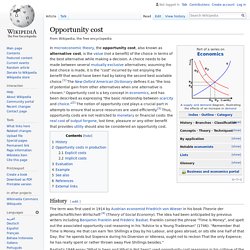
The idea had been anticipated by previous writers including Benjamin Franklin and Frédéric Bastiat. Franklin coined the phrase "Time is Money", and spelt out the associated opportunity cost reasoning in his “Advice to a Young Tradesman” (1746): “Remember that Time is Money. He that can earn Ten Shillings a Day by his Labour, and goes abroad, or sits idle one half of that Day, tho’ he spends but Sixpence during his Diversion or Idleness, ought not to reckon That the only Expence; he has really spent or rather thrown away Five Shillings besides.” Life-cycle assessment. Life-cycle assessment (LCA, also known as life-cycle analysis, ecobalance, and cradle-to-grave analysis)[1] is a technique to assess environmental impacts associated with all the stages of a product's life from-cradle-to-grave (i.e., from raw material extraction through materials processing, manufacture, distribution, use, repair and maintenance, and disposal or recycling).

LCAs can help avoid a narrow outlook on environmental concerns by: Compiling an inventory of relevant energy and material inputs and environmental releases;Evaluating the potential impacts associated with identified inputs and releases;Interpreting the results to help make a more informed decision.[2] Quality-of-life Index. Method[edit] The survey uses nine quality of life factors to determine a nation's score.[1] They are listed below including the indicators used to represent these factors: Health: Life expectancy at birth (in years).
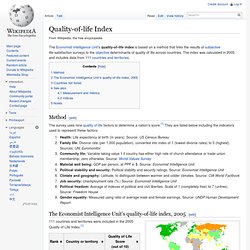
Source: US Census BureauFamily life: Divorce rate (per 1,000 population), converted into index of 1 (lowest divorce rates) to 5 (highest). Sources: UN; EuromonitorCommunity life: Variable taking value 1 if country has either high rate of church attendance or trade-union membership; zero otherwise. Source: World Values SurveyMaterial well being: GDP per person, at PPP in $. Happy Planet Index. Map showing countries shaded by their position in the Happy Planet Index (2006).
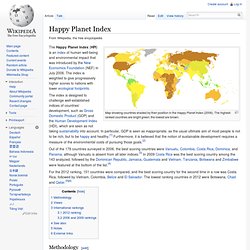
The highest-ranked countries are bright green; the lowest are brown. The index is designed to challenge well-established indices of countries’ development, such as Gross Domestic Product (GDP) and the Human Development Index (HDI), which are seen as not taking sustainability into account. In particular, GDP is seen as inappropriate, as the usual ultimate aim of most people is not to be rich, but to be happy and healthy.[1] Furthermore, it is believed that the notion of sustainable development requires a measure of the environmental costs of pursuing those goals.[2] Out of the 178 countries surveyed in 2006, the best scoring countries were Vanuatu, Colombia, Costa Rica, Dominica, and Panama, although Vanuatu is absent from all later indices.[3] In 2009 Costa Rica was the best scoring country among the 143 analyzed, followed by the Dominican Republic, Jamaica, Guatemala and Vietnam.
Methodology[edit] Pros: Cons: Happiness. Happiness is a mental or emotional state of well-being defined by positive or pleasant emotions ranging from contentment to intense joy.[1] A variety of biological, psychological, religious, and philosophical approaches have striven to define happiness and identify its sources.

Various research groups, including positive psychology, are employing the scientific method to research questions about what "happiness" is, and how it might be attained. Genuine progress indicator. Genuine Progress Indicator, or GPI, is a metric that has been suggested to replace, or supplement, gross domestic product (GDP) as a measure of economic growth.
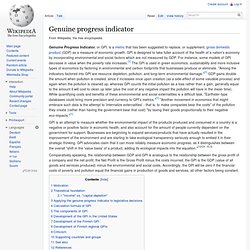
GPI is designed to take fuller account of the health of a nation's economy by incorporating environmental and social factors which are not measured by GDP. For instance, some models of GPI decrease in value when the poverty rate increases.[1] The GPI is used in green economics, sustainability and more inclusive types of economics by factoring in environmental and carbon footprints that businesses produce or eliminate. "Among the indicators factored into GPI are resource depletion, pollution, and long-term environmental damage. GPI is an attempt to measure whether the environmental impact of the products produced and consumed in a country is a negative or positive factor in economic health, and also account for the amount of people currently dependent on the government for support.
Living Planet Index. The 2012 edition of the Living Planet Report The Living Planet Index (LPI) is an indicator of the state of global biological diversity, based on trends in vertebrate populations of species from around the world.
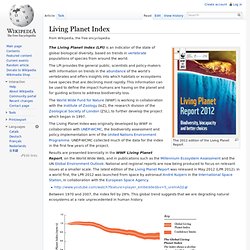
The World Wide Fund for Nature (WWF) is working in collaboration with the Institute of Zoology (IoZ), the research division of the Zoological Society of London (ZSL), to further develop the project which began in 1997. The Living Planet Index was originally developed by WWF in collaboration with UNEP-WCMC, the biodiversity assessment and policy implementation arm of the United Nations Environment Programme. UNEP-WCMC collected much of the data for the index in the first few years of the project.
Satisfaction with Life Index. World map indicating world happiness The Satisfaction with Life Index was created by Adrian G.
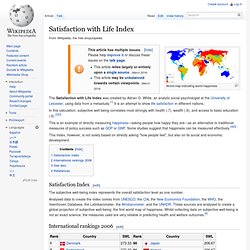
White, an analytic social psychologist at the University of Leicester, using data from a metastudy.[1] It is an attempt to show life satisfaction in different nations. In this calculation, subjective well being correlates most strongly with health (.7), wealth (.6), and access to basic education (.6).[2][3] This is an example of directly measuring happiness—asking people how happy they are—as an alternative to traditional measures of policy success such as GDP or GNP. Some studies suggest that happiness can be measured effectively.[4][5] This Index, however, is not solely based on directly asking "how people feel", but also on its social and economic development. Global Peace Index. Global Peace Index Scores, 2012.
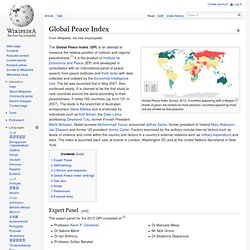
Countries appearing with a deeper shade of green are ranked as more peaceful, countries appearing more red are ranked as less peaceful. World peace. Happy life expectancy. Happy life expectancy is calculated by multiplying life expectancy by a happiness index.

The first uses life expectancy at birth. Self-fulfillment. Self-fulfillment is a concept used in philosophy and, to a lesser degree, psychology, referring to the realizing of one's deepest desires and capacities. The history of this concept can be traced to Ancient Greek philosophers, and although it has been criticized since, it still remains a notable concept in modern philosophy.
Definition and history[edit] The good life. Gender-related Development Index. The Gender-related Development Index (GDI) and the Gender Empowerment Measure (GEM) were introduced in 1995 in the Human Development Report written by the United Nations Development Program. The aim of these measurements was to add a gender-sensitive dimension to the Human Development Index (HDI).
Gender Empowerment Measure. The Gender Empowerment Measure (GEM) is the United Nations Development Programme's attempt to measure the extent of gender inequality across the globe's countries, based on estimates of women's relative economic income, participations in high-paying positions with economic power, and access to professional and parliamentary positions. History[edit] In 1995 in the Human Development Report commissioned by the United Nations Development Program set-out to create two new measurement indices for measuring development. Their aim was to add to the Human Development Index by way of including a gender dimension in the measure. Religion and happiness. Religion and happiness have been studied by a number of researchers, and religion features many elements addressing the components of happiness, as identified by positive psychology. Its association with happiness is facillitated in part by the social connections of organized religion,[1] and by the neuropsychological benefits of prayer[2] and belief.
Research[edit] There are a number of mechanisms through which religion may make a person happier, including social contact and support that result from religious pursuits, the mental activity that comes with optimism and volunteering, learned coping strategies that enhance one's ability to deal with stress, and psychological factors such as "reason for being. " It may also be that religious people engage in behaviors related to good health, such as less substance abuse, since the use of psychotropic substances is sometimes considered abuse.[3][4][5][6][7][8] New Age. The New Age movement is a Western spiritual movement that developed in the second half of the 20th century.
Index of Sustainable Economic Welfare. Carbon thumbprint. A carbon footprint has historically been defined by Championne as "the total sets of greenhouse gas emissions caused by an organization, event, product or person. Human Poverty Index. Personal carbon trading. Personal carbon trading is a general term referring to a number of proposed emissions trading schemes under which emissions credits are allocated to adult individuals on a (broadly) equal per capita basis, within national carbon budgets.[1] Individuals then surrender these credits when buying fuel or electricity. Individuals wanting or needing to emit at a level above that permitted by their initial allocation would be able to purchase additional credits from those using less, creating a profit for those individuals who emit at a level below that permitted by their initial allocation.[2] Proposals[edit] Current proposals include:
Contraction and Convergence. 6 Region C&C Gross and Per Capita Contraction and Convergence (C&C) is a proposed global framework for reducing greenhouse gas emissions to combat climate change. Conceived by the Global Commons Institute [GCI] in the early 1990s, the Contraction and Convergence strategy consists of reducing overall emissions of greenhouse gases to a safe level (contraction), resulting from every country bringing its emissions per capita to a level which is equal for all countries (convergence). It is intended to form the basis of an international agreement which will reduce carbon dioxide emissions to avoid dangerous climate change, carbon dioxide being the gas that is primarily responsible for changes in the greenhouse effect on Earth. Vulnerability index.
Human Development Index. Legatum Prosperity Index. The Legatum Prosperity Index is an annual ranking, developed by the Legatum Institute, of 142 countries. The ranking is based on a variety of factors including wealth, economic growth, education, health, personal well-being, and quality of life. Green national product. Many economists, environmentalists, and citizens have recently criticized the gross national product. The criticism stems from the fact that this measurement of national product does not account for environmental degradation and resource depletion. Sustainability measurement. Ecological footprint. Emissions trading. Environmental full cost accounting. Carbon offset. Emissions Reduction Currency System. Clean Air Conservancy.
Whole-life cost. International Carbon Reduction and Offset Alliance. Green gross domestic product. Cognitive dissonance. Redefining Progress - Research and Publications. Redefiningprogress.org. Millennium Indicators. Gpi1999.pdf (application/pdf Object)